



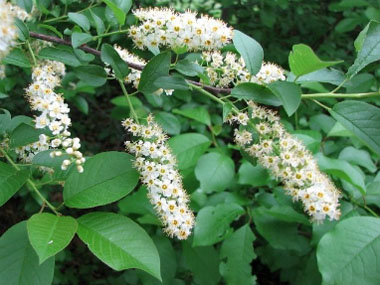
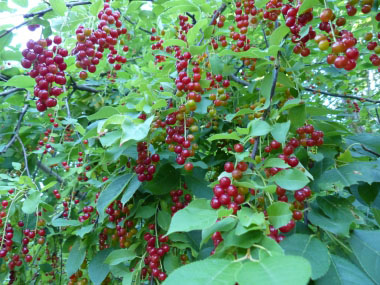
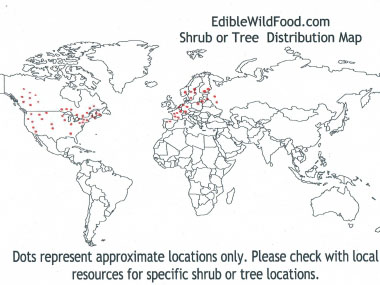

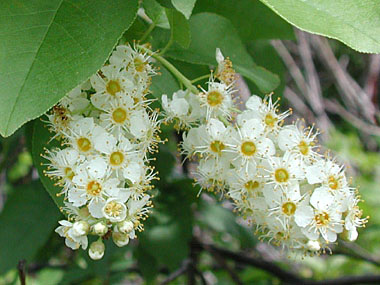

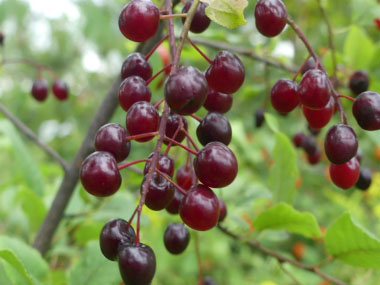
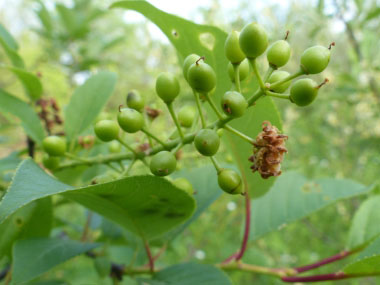
To support our efforts please browse our store (books with medicinal info, etc.).
The chokecherry is a shade intolerant shrub that is in the Rose (Rosaceae) family. Some consider this a tree. Also known as the Eastern Chokecherry or the Red Chokecherry, it often forms shrubby thickets. In Ojibwe this shrub is known as Asasaweminagaawanzh. It grows prolifically from sprouting stumps and root suckers. It grows fast and has a short life span. In fact, on average chokecherries grow 4 to 6 metres (13 to 20') in 40 to 60 years.
Trunk/Bark
The trunks are often twisted and is generally 15cm (6”) in diametre. The bark of the chokecherry is dark grey-brown, becoming darker with age and mature specimens are almost black. Chokecherry bark is smooth or finely scaly. Lenticels are present, but not in horizontal patterns which is characteristic of most other species in the Prunus genus.
Branches/Twigs
Twigs are slender, but stouter than the black cherry. They are light brown to grey and have a strong unpleasant odour when broken. Buds are 8mm (1/3”) long covered with brownish scales.
Height
This shrub can reach to 8 metres (26 ft) tall.
Leaves/Needles
The leaves grow alternate, simple, oblong to nearly oval, 5 to 10 cm (2 to 4”) long, finely serrated margin, with an almost hair-like tip. Leaves are dark green above and paler below, and there are minute glands on petiole.
Flowers
Chokecherry flowers are white, found in loose, cylindrical clusters (long terminal raceme) that range from 8 to 15cm (3 to 6”) long. Chokecherries usually flower in May to early June.
Fruit
Dark red to purple drupe, 8mm (1/3”) in diameter, maturing in late summer. Mature fruit hangs in clusters of 6 to 12.
Habitat
Chokecherries are often found in open woodlands located on rocky terrain or other disturbed sites. It prefers part to full sun. They also grow well in rich soils. Chokecherry bushes can be found throughout Canada and the U.S.
Edible Parts
This unique fruit can be eaten fresh or cooked, but the pit should never be eaten unless the berries have been cooked or dried. The pit (not the fruit) contains hydrocyanic acid, which is poisonous. The acid in the pit is destroyed when the berries are cooked or dried. It is important to note that all parts of the tree with the exception of the cherry flesh contain hydrocyanic acid.
Other Name
Virginia Chokecherry.
Winter Survival Food Handbook

PDF Plant Magazines
Types of Wild Food
Geographic Zones Seasons
Disclaimer
EdibleWildFood.com is informational in nature. While we strive to be 100% accurate, it is solely up to the reader to ensure proper plant identification. Some wild plants are poisonous or can have serious adverse health effects.
We are not health professionals, medical doctors, nor are we nutritionists. It is up to the reader to verify nutritional information and health benefits with qualified professionals for all edible plants listed in this web site. Please click here for more information.
Why Edible Wild Food?
- Food costs are rising
- Free, wild food is readily abundant
- Wild food adds nutrition to your diet
- Wild food can help treat various medical conditions





